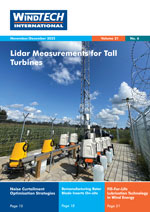Vattenfall is supporting the AIRTuB-ROMI initiative in the Netherlands to enhance offshore wind maintenance through in-blade monitoring and drone-crawler robots. The project, backed by the Dutch Ministry of Economic Affairs and an industry–academic collaboration, will assess three different sensor technologies embedded in turbine blades.
When the sensors detect an anomaly, artificial intelligence algorithms predict potential damage and its location. A drone-crawler is then automatically deployed from its offshore docking station within the wind farm to carry out further inspection. After take-off, the drone autonomously captures high-resolution images of the blades from multiple angles before landing on the blade to perform an ultrasonic scan of the potentially damaged area. This process provides a complete assessment of the blade’s structural health, allowing the maintenance team to plan repairs as needed.
Thanks to advanced sensors and artificial intelligence–powered software, cargo drones can fly safely in complex offshore environments, avoiding obstacles and adapting to changing weather conditions. They can transport materials and equipment from a service operation vessel (SOV) to wind turbines, reducing the need for vessels to make multiple trips. Using an unmanned air vessel (UAV) speeds up material delivery, saves time, and reduces CO2 emissions by eliminating the need for a crew transfer vessel (CTV). This approach was recently tested at Vattenfall’s offshore wind farms DanTysk and Sandbank in the German North Sea.
During installation works at the Hollandse Kust Zuid offshore wind farm in the Dutch North Sea, Vattenfall deployed the 12-metre-long uncrewed surface vessel Blue Essence, equipped with an electrical remotely operated vehicle (eROV) for inspections and seabed mapping. Developed in close collaboration with partner Fugro, this technology reduces reliance on crewed vessels, accelerates inspections, and minimises environmental impact. The uncrewed vessel with eROV features advanced sensors, sonar, and high-definition cameras that provide real-time data on cable and foundation conditions.
Both the uncrewed vessel and eROV can operate 24/7, withstand wind speeds of up to 38 kilometres per hour (wind force 5), and handle wave heights of up to one and a half metres. They are remotely operated from Fugro’s control rooms in Aberdeen, Scotland.










